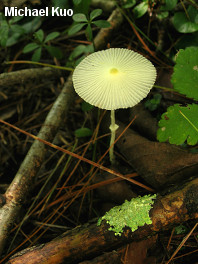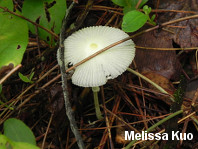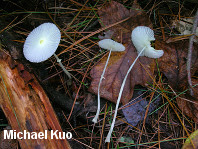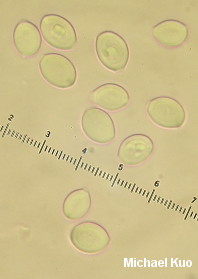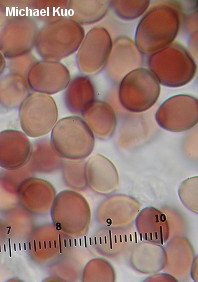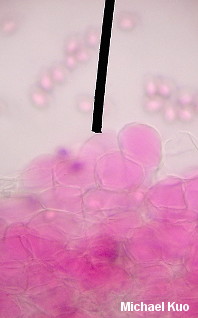| Major Groups > Gilled Mushrooms > Pale-Spored > Lepiotoid Mushrooms > Leucocoprinus fragilissimus |

|
Leucocoprinus fragilissimus [ Basidiomycota > Agaricales > Agaricaceae > Leucocoprinus . . . ] by Michael Kuo This tiny lepiotoid mushroom is so exceedingly fragile that collecting it and preserving it for study presents a real challenge. The stem is quite long, proportionally, but so skinny that it breaks with the slightest pressure--and the cap begins to dissolve and collapse within a few hours of expanding. Leucocoprinus fragilissimus is found in southeastern North America, from Texas to Florida, Maryland, and southern Ohio. Its fragile stature, deeply grooved cap, pale yellow colors, and flimsy ring make it fairly easy to identify, but compare it with Leucocoprinus flavescens, which is a tad sturdier and features much smaller spores. Additionally, Helen Smith (1982) describes Leucocoprinus magnicystidiosus, from Texas, featuring brighter yellow colors and, more conclusively, large pleurocystidia. Description: Ecology: Saprobic; growing alone or scattered, in humus; summer; distributed in the southeastern United States, from Texas to the southern Appalachians; also reported from Costa Rica. The illustrated and described collection is from Ohio. Cap: 1.5-4.5 cm across; planoconvex, becoming nearly flat, with a small central bump; very fragile, and soon collapsing; deeply grooved from the margin to the center; dry or moist; pale greenish yellow, with a slightly darker center; fading to nearly white, with a yellowish center. Gills: Free from the stem; distant; pale yellow; often dissolving in hot weather. Stem: 4-9 cm long; 1-2 mm thick; equal above a small basal bulb; exceedingly fragile; bald; pale yellow, fading to nearly white; with a thin, fragile, yellow ring that sometimes disappears. Flesh: Insubstantial; yellowish. Odor: Not distinctive. Chemical Reactions: KOH negative on cap surface. Spore Print: White. Microscopic Features: Spores 9-12 x 7-8 µ; broadly ellipsoid; with a large (2 µ) pore at one end, creating a sublimoniform impression; smooth; hyaline in KOH; dextrinoid. Brachybasidioles abundant in young caps. Pleurocystidia absent. Cheilocystidia clavate; soon collapsing. Pileipellis cellular/hymeniform; terminal elements subglobose, 15-25 µ wide, hyaline in KOH. REFERENCES: (Ravenel in Berkeley & Curtis, 1853) Patouillard, 1900. (Saccardo, 1887; H. Smith & Weber, 1982; Smith & Weber, 1985; Metzler & Metzler, 1992.) Herb. Kuo 07281201. This site contains no information about the edibility or toxicity of mushrooms. |
© MushroomExpert.Com |
|
Cite this page as: Kuo, M. (2015, May). Leucocoprinus fragilissimus. Retrieved from the MushroomExpert.Com Web site: http://www.mushroomexpert.com/leucocoprinus_fragilissimus.html |
